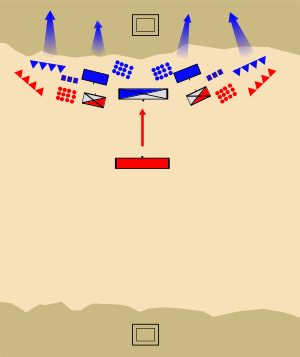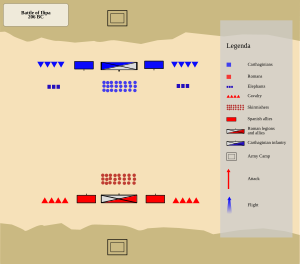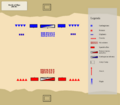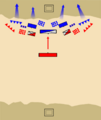Battle of Ilipa facts for kids
Quick facts for kids Battle of Ilipa |
|||||||
|---|---|---|---|---|---|---|---|
| Part of the Second Punic War | |||||||
 |
|||||||
|
|||||||
| Belligerents | |||||||
| Commanders and leaders | |||||||
| Publius Cornelius Scipio Lucius Marcius Septimus Marcus Junius Silanus |
Hasdrubal Gisco Mago Barca |
||||||
| Strength | |||||||
| Polybius: 48,000 men • 45,000 infantry • 3,000 cavalry Livy: 55,000 men |
Polybius: 74,000 men • 70,000 infantry • 4,000 cavalry 32 war elephants Livy: 54,500 men • 50,000 infantry • 4,500 cavalry Unknown number of elephants |
||||||
| Casualties and losses | |||||||
| 7,000 killed | 48,500 killed or captured | ||||||
The Battle of Ilipa was a huge battle during the Second Punic War in 206 BC. Many people think it was the most amazing victory for the Roman general Scipio Africanus. It probably happened on a flat area east of Alcalá del Río, near Seville, Spain. This was close to where the Carthaginian army had set up their camp.
Scipio's clever plan before the battle and his special "reverse Cannae" formation showed how brilliant he was at military tactics. This battle helped the Romans finally take control of Iberia (modern-day Spain and Portugal). It stopped the Carthaginians from sending more armies into Italy and cut off their supply of silver and soldiers.
Contents
Getting Ready for Battle
After the Battle of Baecula, the Carthaginian general Hasdrubal Barca left Iberia. In early 207 BC, new Carthaginian soldiers arrived in Iberia. They were led by Hanno and soon joined up with Mago Barca. Together, they started gathering a large army by hiring many Celtiberian mercenaries (soldiers from ancient Spain).
At the same time, another Carthaginian general, Hasdrubal Gisco, moved his army from Gades into Andalusia. This meant Scipio was facing two large enemy armies. He knew that if he attacked one, the other might attack him from behind.
Scipio's Clever Plan
Scipio thought carefully about what to do. He decided to send a small group of soldiers, led by Marcus Junius Silanus, to attack Mago first. Silanus marched very quickly and completely surprised the Carthaginians in their camps. Mago's Celtiberian soldiers scattered, and Hanno was captured.
This left Hasdrubal Gisco alone to face Scipio's main army. However, Hasdrubal managed to avoid a big battle by spreading his troops out among strong, fortified cities. So, the fighting in Iberia in 207 BC ended without another major clash.
The Armies Gather
The next spring, the Carthaginians made one last big effort to win back their lands in Iberia. Mago joined Hasdrubal Gisco at Ilipa. Their combined force was estimated to be between 54,000 and 74,000 soldiers. Scipio's army was smaller, with about 48,000 men. Many of Scipio's soldiers were Spanish allies who were not as experienced as the Roman legionaries.
However, some historians, like Livy, say the Carthaginian army had 50,000 foot soldiers and 4,500 horsemen. Livy also suggests Scipio's army might have been slightly larger, with 55,000 men.
Surprise Attack and Roman Strategy
When the Romans arrived, Mago launched a bold attack on the Roman camp. He used most of his cavalry, led by his Numidian ally Masinissa. But Scipio had expected this! He had hidden his own cavalry behind a hill. This Roman cavalry then charged into the side of the Carthaginian attack, pushing them back with heavy losses for Mago.
For the next few days, both armies watched each other and tested their strengths. Scipio always waited for the Carthaginians to move out of their camp first before he led his own troops out. The Roman army always lined up with their best soldiers (legions) in the middle and their Spanish allies on the sides. This made Hasdrubal and Mago believe that this would be the Roman battle plan every time.
The Main Battle Begins
Scipio believed his trick had worked on the Carthaginian commanders. So, he made his move. First, he ordered his army to eat and get ready before daylight. Then, at dawn, he quickly sent his cavalry and light soldiers (called velites) to attack the Carthaginian outposts. His main army followed behind, marching all the way to the front of the Carthaginian position. But this day, Scipio changed his formation: his best Roman soldiers (legions) were on the sides, and his Spanish allies were in the middle.
The Carthaginians were surprised by the Romans' sudden attack. They quickly grabbed their weapons and rushed out of their camp without eating breakfast. They still thought Scipio would line up his army the way he had before. So, Hasdrubal put his best African soldiers in the middle and his Spanish mercenaries on the sides. He couldn't change his formation once he saw the new Roman setup because Scipio's army was too close.
Scipio's "Reverse Cannae" Plan
For the next few hours, Scipio held back his main foot soldiers. He let his light troops keep fighting the Carthaginians. This made the Carthaginians even hungrier and more tired because they hadn't eaten breakfast. When Scipio finally decided to attack, he called his light troops back. They moved through gaps in the main Roman lines and positioned themselves behind the legions on the sides. Then, the main attack began.
Scipio's soldiers on the sides marched faster than the Spanish allies in the middle. This created a curved battle line, shaped like a "U" or a "reverse Cannae." Scipio also made his sides even stronger. He ordered the light troops to move to the very edges of the legions, and the cavalry to the edges of the light troops. This meant the Roman army completely surrounded the Carthaginian battle line on both sides.
Scipio still held back his middle section. His Roman legions, light troops, and cavalry attacked the less-trained Spanish soldiers on the Carthaginian sides from the front, the side, and the back. The Carthaginian middle was helpless. They couldn't help their sides because Scipio's Spanish allies were threatening them from the front, even though they weren't attacking yet.
Carthaginian Collapse
As their sides were being destroyed, the Carthaginian middle became even more confused and scared. Their own maddened elephants were being driven towards the center by the Roman cavalry attacking the sides, trampling their own soldiers. All this, combined with hunger and tiredness, made the Carthaginians start to retreat. At first, they retreated in an orderly way.
But then Scipio pushed his advantage. He ordered his Spanish allies in the center to attack. The Carthaginian army completely fell apart. A huge slaughter, like the one at the Battle of Cannae, was only stopped by a sudden heavy rainstorm. This stopped all the fighting and allowed the remaining Carthaginians to escape to their camp.
After the Battle
Even though they were safe in their camp for a short time, the Carthaginians couldn't rest. They knew the Romans would attack again the next morning, so they had to make their defenses stronger. But as the night went on, more and more Spanish mercenaries left the Carthaginian army. Hasdrubal tried to sneak away with his remaining men in the darkness.
Scipio immediately ordered his army to chase them. Led by the cavalry, the entire Roman army was right behind Hasdrubal. When the Romans finally caught up with the Carthaginian army, a terrible slaughter began. Hasdrubal was left with only 6,000 men, who then ran to the top of a mountain where there was no water. This small group of Carthaginian soldiers surrendered a short time later. However, Hasdrubal and Mago managed to escape.
What Happened Next
After the battle, Hasdrubal Gisco went to Africa to visit the powerful Numidian king Syphax. Interestingly, Scipio was also at Syphax's court, trying to get the Numidians to support the Romans.
Mago Barca fled to the Balearics (islands in the Mediterranean Sea). From there, he sailed to Liguria (in northern Italy) and tried to invade northern Italy.
Scipio finally took control of all Carthaginian lands in Iberia. He also got revenge on the Iberian chiefs who had betrayed his father and uncle, which had led to their deaths. After this, Scipio returned to Rome. He was elected consul (a top Roman leader) in 205 BC with almost everyone voting for him. The Senate (Roman government) then agreed that he would control Sicily as a proconsul (a governor). From Sicily, Scipio planned his invasion of Carthage's homeland in Africa.
Images for kids
See also
 In Spanish: Batalla de Ilipa para niños
In Spanish: Batalla de Ilipa para niños




